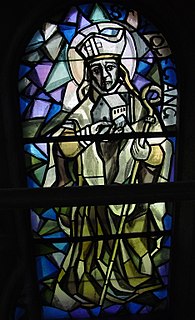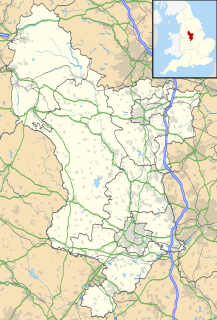
Monte Cassino is a rocky hill about 130 kilometres (80 mi) southeast of Rome, in the Latin Valley, Italy, 2 kilometres west of Cassino and at an elevation of 520 m (1,710 ft). Site of the Roman town of Casinum, it is best known for its abbey, the first house of the Benedictine Order, having been established by Benedict of Nursia himself around 529. It was for the community of Monte Cassino that the Rule of Saint Benedict was composed.

Maximin was the sixth bishop of Trier. Maximin was an opponent of Arianism, and was supported by the courts of Constantine II and Constans, who harboured as an honored guest Athanasius twice during his exile from Alexandria, in 336–37 and again in 343. In the Arian controversy he had begun in the party of Paul I of Constantinople; however, he took part in the synod of Sardica convoked by Pope Julius I, and when four Arian bishops consequently came from Antioch to Trier with the purpose of winning Emperor Constans to their side, Maximinus refused to receive them and induced the emperor to reject their proposals.

Saint-Maximin-la-Sainte-Baume is a commune in the southeastern French department of Var, in the Provence-Alpes-Côte d'Azur region. Located 40 km (25 mi) east of Aix-en-Provence, the town lies at the foot of the Sainte-Baume mountains. Baume or bama is the Provençal equivalent of cave. The town's basilica is dedicated to Mary Magdalene.

Saint Wolfgang of Regensburg was bishop of Regensburg in Bavaria from Christmas 972 until his death. He is a saint of the Catholic and Eastern Orthodox churches. He is regarded as one of the three great German saints of the 10th century, the other two being Saint Ulrich of Augsburg and Saint Conrad of Constance. Towards the end of his life Wolfgang withdrew as a hermit to a solitary spot, in the Salzkammergut region of Upper Austria. Soon after Wolfgang's death many churches chose him as their patron saint, and various towns were named after him.

Tegernsee Abbey is a former Benedictine monastery in the town and district of Tegernsee in Bavaria. Both the abbey and the town that grew up around it, are named after the Tegernsee, the lake on the shores of which they are located. The name is from the Old High German tegarin seo, meaning great lake.

Tholey Abbey in Tholey, in the district of Sankt Wendel in Saarland, is a Benedictine monastery dedicated to Saint Maurice. It is part of the Beuronese Congregation within the Benedictine Confederation.
Saint-Maximin may refer to several places:
Milo of Trier was the son of St. Leudwinus and his successor as Archbishop of Trier and Archbishop of Reims. His great-uncle Saint Basinus had preceded his father as Archbishop of Trier. He was the great-grandson of Saint Sigrada and Saint Leodegarius was his great uncle.

The Abbey of Echternach is a Benedictine monastery in the town of Echternach, in eastern Luxembourg. The Abbey was founded in the 7th century by St Willibrord, the patron saint of Luxembourg. For three hundred years, it benefited from the patronage of a succession of rulers, and was the most powerful institution in Luxembourg.

Gorze Abbey was a Benedictine monastery in Gorze in the present arrondissement of Metz, near Metz in Lorraine. It was prominent as the source of a monastic reform movement in the 930s.

Dijon Cathedral, or at greater length the Cathedral of Saint Benignus of Dijon, is a Roman Catholic church located in the town of Dijon, Burgundy, France, and dedicated to Saint Benignus of Dijon. The Gothic cathedral building, constructed between 1280 and 1325, and dedicated on 9 April 1393, is a listed national monument.

The Roman Catholic Archdiocese of Luxembourg is an archdiocese of the Latin Rite of the Catholic Church in the Grand Duchy of Luxembourg, comprising the entire Grand Duchy. The diocese was founded in 1870, and it became an archdiocese in 1988. The seat of the archdiocese is the Cathedral of Notre Dame in the city of Luxembourg, and since 2011 the archbishop is Jean-Claude Hollerich.
Lobbes Abbey was a Benedictine monastery in Lobbes in Hainaut, Belgium. The abbey played an important role in the religious, political and religious life of the Prince-Bishopric of Liège, especially around the year 1000. In addition to its founder St Landelin, 4 other saints are said "of Lobbes".
Klingenmünster Abbey was a Benedictine monastery in the village of Klingenmünster in Bad Bergzabern, Rhineland-Palatinate, Germany.

Saint-Germer-de-Fly Abbey is a former Benedictine abbey located in the village of Saint-Germer-de-Fly, in Picardy in the Oise département of France. Only the late Romanesque-early Gothic church remains, now the village parish church. It is regarded as one of the earliest manifestations of the Gothic style in France. A Gothic chapel added in the mid-13th century is noted as a smaller-scale reinterpretation of the Sainte-Chapelle of Paris.

St. Matthias' Abbey is a Benedictine monastery in Trier, Rhineland-Palatinate, Germany.

The Church of Saint Pantaleon is an early Romanesque church in Cologne, Germany. The church dates back to the 10th century and is one of the twelve Romanesque churches of Cologne. The former monastery church is consecrated to Saint Pantaleon and the Saints Cosmas and Damian and is the oldest church of the cult of Saint Pantaleon west of Byzantium. The empress Theophanu and the archbishop Bruno the Great are buried in the church, which also contains shrines of saints Alban, the first Christian martyr of Britain, and Maurinus of Cologne. Pope Benedict XVI visited the church in 2005.

Repton Abbey was an Anglo-Saxon Benedictine abbey in Derbyshire, England. Founded in the 7th century, the abbey was a double monastery, a community of both monks and nuns. The abbey is noted for its connections to various saints and Mercian royalty; two of the thirty-seven Mercian Kings were buried within the abbey's crypt. The abbey was abandoned in 873, when Repton was overrun by the invading Great Heathen Army.

The Rheinische Landesmuseum Trier is an archaeological museum in Trier, Germany. The collection stretches from prehistory through the Roman period, the Middle Ages to the Baroque era with a strong emphasis on the Roman past of Augusta Treverorum, Germany's oldest city. Its collections of (local) Roman sculptures, Roman mosaics and frescos are among the best in Germany.

Altmünster Abbey was a Benedictine monastery on the Plateau Altmünster, between the Fishmarket and Clausen areas of Luxembourg City.



















